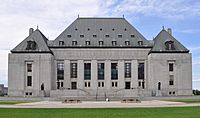R v Guerin facts for kids
Quick facts for kids Guerin v The Queen |
|
|---|---|

|
|
| Hearing: June 13, 14, 1983 Judgment: November 1, 1984 |
|
| Full case name | Delbert Guerin, Joseph Becker, Eddie Campbell, Mary Charles, Gertrude Guerin and Gail Sparrow v Her Majesty The Queen |
| Citations | [1984] 2 S.C.R. 335 |
| Ruling | Guerin appeal allowed. |
| Court membership | |
| Chief Justice: Bora Laskin Puisne Justices: Roland Ritchie, Brian Dickson, Jean Beetz, Willard Estey, William McIntyre, Julien Chouinard, Antonio Lamer, Bertha Wilson |
|
| Reasons given | |
| Majority | Dickson J., joined by Beetz, Chouinard and Lamer JJ. |
| Concurrence | Wilson J., joined by Ritchie and McIntyre JJ. |
| Concurrence | Estey J. |
| Laskin C.J. took no part in the consideration or decision of the case. | |
Guerin v The Queen was a very important case decided by the Supreme Court of Canada in 1984. This case was about the rights of Indigenous peoples in Canada. The Court said that the Canadian government has a special responsibility, called a fiduciary duty, to First Nations. It also said that Aboriginal title (the right to land) is a unique kind of right.
Contents
How a Golf Course Led to a Big Court Case
The Musqueam First Nation owned about 416 acres (1.68 square kilometers) of valuable land near Vancouver. In 1958, the Canadian federal government, acting for the Musqueam, made a deal. They agreed to lease 162 acres (0.66 square kilometers) of this land to the Shaughnessy Heights Golf Club. The golf club wanted to build a course there.
However, the Musqueam Band was not told the full details of the agreement. The government gave them different, less favorable terms than what was actually agreed upon with the golf club.
In 1970, the Musqueam Band found out the real terms of the lease. They felt the government had not been honest with them. They argued that the government had a duty to explain the deal properly.
The case went to court. At first, a lower court agreed with the Musqueam. It said the government had broken its trust with the Band. The court ordered the government to pay the Musqueam ten million dollars. But this decision was later changed by another court, the Federal Court of Appeal. So, the Musqueam took their case to the highest court in Canada, the Supreme Court of Canada.
The case was named after Delbert Guerin, who was the chief of the Musqueam Band at the time. He said his mother, Gertrude Guerin, who was also a chief before him, inspired the case. He explained that listening to her complaints led to the Guerin case.
The Supreme Court's Decision
The Supreme Court of Canada made a very important ruling. Justice Dickson, along with other judges, said that the government has a special "fiduciary duty" to First Nations. This means the government must act in the best interests of First Nations when dealing with their land and rights.
The Court also described Aboriginal title as a sui generis right. This means it is a "one-of-a-kind" or "unique" right. It is a legal right that existed before Canada was formed. It was not created by any law like the Royal Proclamation of 1763 or the Indian Act. This special right means that Aboriginal land can only be given to the Crown (the government). The Crown must then use this land only to benefit the Aboriginal people.
The Court found that the government's representatives had promised the Musqueam Band certain terms for the land lease. But they actually leased the land on different terms that were much less valuable to the Band. The judges decided it was wrong for the government to ignore the promises made to the First Nation. They used ideas from fairness and law, saying that someone working for another person must always act in that person's best interests.
Because the government had broken its special duty, the Supreme Court decided that the money awarded by the first court should be paid to the Musqueam Band. This payment would make up for the Band's losses.
What Happened Next
The idea of "fiduciary duty" from the Guerin case became very important. It helped judges understand and protect Aboriginal rights under Section 35 of the Constitution Act, 1982. This section of Canada's Constitution protects the rights of Indigenous peoples.
See also

